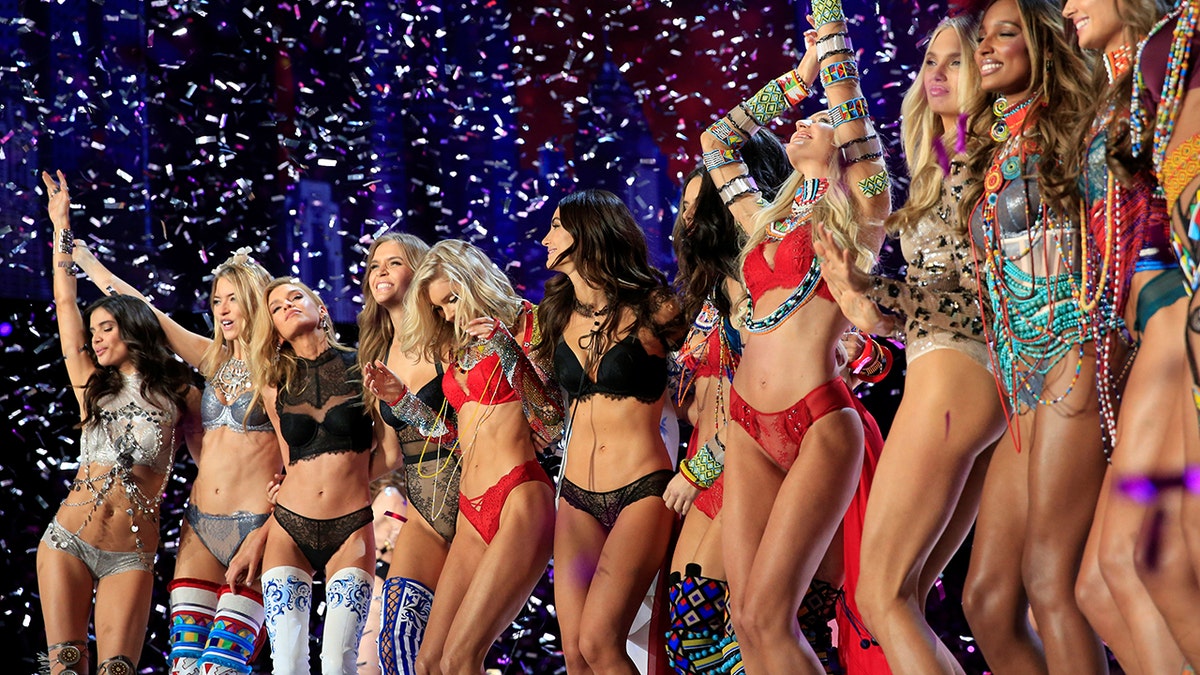
Prepping for this year's show in Shangai is serious business. (Reuters)
Supermodel Lais Ribeiro strutted her lithesome 6-foot frame across the stage last November at the annual Victoria’s Secret Fashion Show, her 31-23-33 figure barely contained in the company’s Fantasy Bra.
The crowd went crazy, and it was difficult to know if they were cheering the $2 million bejeweled bra Ribeiro was wearing or the Brazilian beauty herself.
By most measures, the Nov. 20 extravaganza in Shanghai, China, was a success. Ribeiro and a dozen of her supermodel pals were at their sexy best in an estimated $12 million production that company executives arranged to have telecast around the world.
But the world yawned.
KATE SPADE SALES INCREASE 31 PERCENT AFTER FOUNDER'S DEATH
Viewership of the show plummeted 32 percent from the previous year in the coveted demographic — to just 5 million. The company insists it is still the most watched fashion event in the world and that more people are tuning in online.
That may be true, but the 41-year-old brand that sells sleek and sexy has clearly grown tired in its middle age, critics say.
Once among the hottest and most buzzed about brands in the world, Victoria’s Secret has posted declining same-store sales at its brick-and-mortar US locations for seven straight quarters, while profit margins have gotten squeezed and inventories bloated.
Investors in L Brands, the lingerie maker’s parent company, are taking a beating as shares are down more than 45 percent this year — making it the worst-performing stock in the S&P 500.
In hopes of turning things around, company execs have cut prices and extended its sales longer. Neither has worked as sales per square foot, down in the last two years, continued to erode in the first quarter.
Perhaps even more troubling, younger and more aggressive rivals are now circling Victoria’s Secret like a bunch of hungry sharks — each with a marketing pitch that is resonating with young women.
“Victoria’s Secret is an example of a company that thought it was too big to fail,” Lingerie Addict editor and founder Cora Harrington told The Post. “I don’t think they ever considered that American consumers would go elsewhere.”
TEXAS WOMAN ARRESTED FOR MARIJUANA TAKES MUGSHOT, GETS REQUESTS FOR MAKEUP TIPS
Walk into almost any of the 1,124 Victoria’s Secret stores across the US, and you can instantly see the problem. Where are all the shoppers?
There’s looping video footage of Angels walking the runway, seductive framed photos of them hanging above the lingerie displays, and throbbing music. But one recent afternoon inside the chain’s Midtown Manhattan flagship — the bras and panties on display, meticulously stacked and seemingly untouched — spoke volumes about store traffic, or the lack of it.
The company has admitted in regulatory filings its customer traffic in stores is troubling.
One sale — 5 panties for $28.50 — stretched longer than usual, but to no apparent benefit. Sales at the brick-and-mortar stores were down 5 percent in the first quarter after falling 6 percent in 2017 and 1 percent in 2016. Its teen-focused Pink brand — which has fueled most of the lingerie company’s gains over the past five years — started to cool late last year and has not rebounded. Operating income for Victoria’s Secret has decreased 33 percent since 2015.
What went wrong? How could an iconic retailer that was the standard bearer of all things sexy, with oodles of pricing power and a stable of super models, fall so hard?
Self-inflicted wounds, say industry experts.
Victoria’s Secret’s once-effective marketing strategy of using super models — Heidi Klum, Gisele Bundchen and Gigi Hadid are Angel alums —has for the most part backfired on the Columbus, Ohio, company.
“It’s had the same positioning for decades, associating sexy with super models, and it just doesn’t work anymore,” said Konik.
The #MeToo movement that exploded on the public consciousness last October didn’t help. The brand’s image has been banged up since then, according to a recent survey by YouGov.
FOLLOW US ON FACEBOOK FOR MORE FOX LIFESTYLE NEWS
“The Angels are unrelatable, while the stores look too much like an outdated boudoir,” observed retail consultant Gabriella Santaniello of A-Line Partners.
Victoria’s Secret watched on the sidelines as a growing number of rivals seized on fashion trends like bralettes and plus sizes — and thrived. It also failed to react as new competitors, like American Eagle’s Aerie brand, undercut its pricing by as much as half.
Aerie reported a 38 percent spike in comparable store sales in the first quarter this year largely on the strength of its #AerieREAL campaign that featured unretouched photos of both professional models and ordinary customers.
Last month Aerie unveiled a marketing campaign featuring women with various medical conditions and diseases, including a young woman with an insulin pump protruding from her belly and another with the skin pigmentation disease, vitiligo.
AerieREAL grew from a no-retouching campaign in 2014 to a body positivity and empowerment campaign, a spokesperson told The Post.
